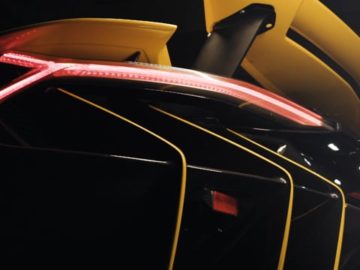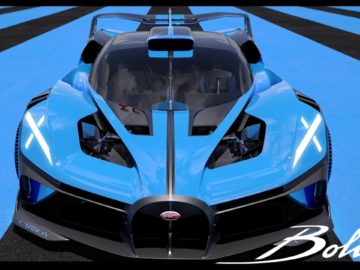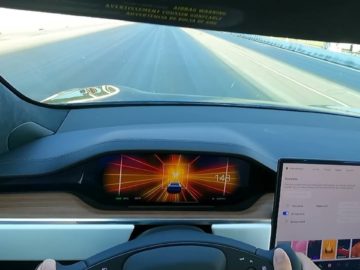
Bloodhound SSC set to debut September 24, we get a preview
[ad_1]
Green will be behind the wheel again in the Bloodhound, backed up by a team full of Thrust SSC alums, including team principle and former land-speed-record holder Richard Noble and aerodynamics chief Ron Ayres. And if all goes according to plan at the 11.8-mile stretch of Hakskeen Pan in South Africa next year, the team will return to the desert in 2017 to write a quadruple-digit speed into the history books. Not even fighter jets have traveled this fast at low altitude.
If all goes according to plan the team will return to the desert to write a quadruple-digit speed into the history books.
“For the last few years we’ve had plastic models, CGI, and last Christmas we showed a sort of Airfix Kit of all the bits we had, but this will be 98 percent the finished car,” says Mark Chapman, Bloodhound’s chief engineer. “There’s a couple of bits we’re still waiting on – a few airbrake parts, for example – and then we’re all ready to run and go testing. It’s less shiny and a bit bumpier [than the show cars] and you’ll be able to see the gaps between the panels, the hatches, the imperfections, and its character. It’s all getting close now. For the first time in my eight years with this project, this is the real thing.”
When we spoke to him at the end of August, Chapman was still concerned about the massive 8-by-6-foot tail fin, built by engineers at the Royal Air Force 71 squadron (the team normally handles inspection and repair of fixed-wing aircraft). The intricate structure will keep the car stable and carry the names of all of Bloodhound’s sponsors on its hand-crafted skin.
“Next week the final colors are going on, it’s going to be decal’d up, and then we’re going to try and get the fin on,” says Chapman. “Although the show car looks big, this will look even bigger and the main difference is that fin size. It doesn’t fit too well in a trailer or in exhibition spaces, but this is the real car with the real fin and even for us on the project, I think we’re all going to take a step back and say, ‘hmm, it’s big’.”
The car will show one side with the panels and wheels as it will run in South Africa. The other side will be the runway spec used for test runs at RAF St Mawgan/Newquay aerodrome in South West England either this autumn or next spring.
“With the runway wheels and tires and a few of the body panels off so you can actually see why the car is 14 meters long,” says Chapman. “The guys have been working hard for the last three weeks, the systems are in, the pneumatics, the hydraulics, the electronics, and the rockets. And although it needs to be taken apart again and built up, all the systems are being tested as we’re going along.”

This is what’s known as a dry build, where everything is test-fitted to check fit and finish as well as the operating systems. It’s that process and the lessons that they learn from it that Chapman considers so important. “It’s things like the electronics,” he says. “Does the jet ECU [electronic control unit] speak to the jet and can we talk to the air-brake systems? The cockpit will be all wired up and so we’ll be able to talk about how the whole machine starts to live. “There are some things we got wrong and some that have gone better than we thought,” he says. “It will be a case of stepping back and looking at how we can get things better. Silly little things like electrical boxes which we can’t get to very easily because of the way the bolts are installed. Because the car’s been designed over so many years, there’s a lot of things that have changed. So the front end is like it is, but we now don’t have a Cosworth engine and the rocket’s fuel pumps’ auxiliary drive motor has been changed three times. As of now it’s a dry-sump version of the AJ133 V8 from the Jaguar F-Type, and it will pump 800 liters of high-test peroxide into the rocket in 20 seconds.”
From the starting line to a full stop, the entire run will take two minutes.
The 1,000-mph run will use three rockets. Two different engines are being prepared; one for the high-speed runs in Newquay and then South Africa, the other to go to Norway for the rocket development being undertaken by rocket-maker Nammo.
“We also need to get our engineers looking at the turnaround,” he says. From the starting line to a full stop, the entire run will take two minutes: 55 seconds in acceleration, 3.5 seconds through the measured mile, and the rest to slow down. The rules from the FIA state that the record is the flying speed over a fixed distance, averaged over two passes in opposite directions conducted within an hour. That means the Bloodhound needs to stop, get turned around, checked, and refueled in about 55 minutes.
For now that challenge is still a long way off. But the unveiling later this month is a huge step in the Bloodhound’s long development. “It’s a little way away from putting in some jet fuel and roaring down a runway, but September 24 will be a celebration of what we’ve got and where we are,” says Chapman. “This now looks like a car that’s going to go pretty quick”.
Related Video:

[ad_2]
Source link









